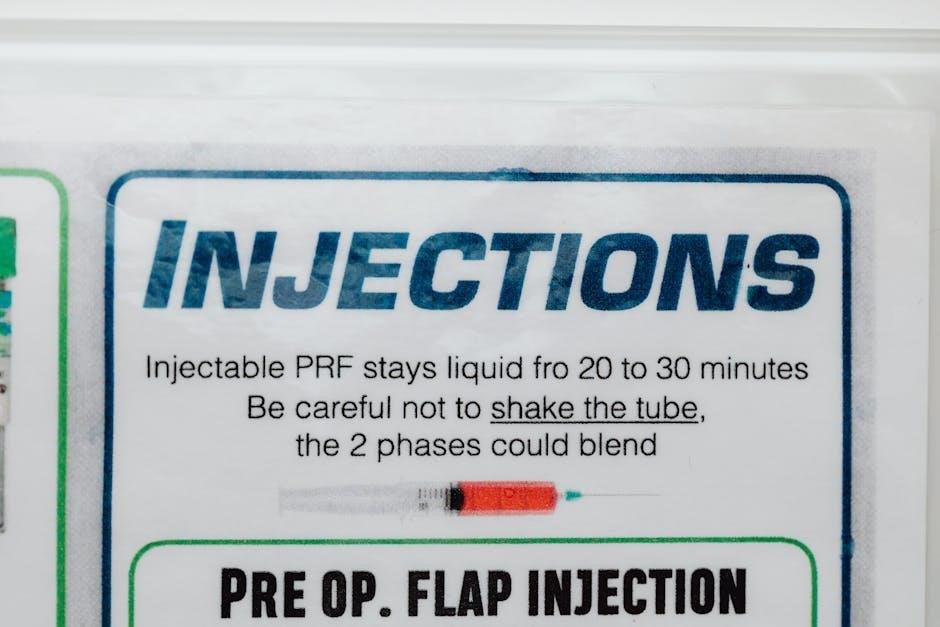Rocksett is a high-temperature thread locker and adhesive designed to secure parts under extreme heat conditions. It ensures reliable bonds and prevents loosening over time effectively.
1.1 What is Rocksett?
Rocksett is a high-temperature thread locker and adhesive designed to secure parts under extreme heat conditions. It ensures reliable bonds and prevents loosening over time. Commonly used in firearms and industrial applications, Rocksett provides a strong seal and lock, making it ideal for components exposed to high thermal stress. Proper application involves a thin, even layer to achieve optimal performance and durability.
1.2 Importance of Proper Application
Proper application of Rocksett is crucial to ensure a strong, reliable bond and prevent issues like loosening or uneven adhesion. Using the correct amount and distributing it evenly guarantees optimal performance, especially under high heat. Improper application can lead to parts coming loose or uneven bonding, compromising the integrity of the assembly. Always follow manufacturer guidelines for best results and longevity of the bond.

Preparation for Using Rocksett
Proper preparation ensures effective application. Clean surfaces thoroughly with iso alcohol, apply a small amount evenly, and use tools like brushes or toothpicks for precision.
2.1 Cleaning the Surfaces
Clean both muzzle device and barrel threads thoroughly with isopropyl alcohol to remove grease and debris. This ensures a strong bond by allowing Rocksett to adhere properly. Use a clean cloth to wipe away residue and let surfaces dry completely before application. Proper cleaning is essential for optimal performance and longevity of the seal.
2.2 Tools and Materials Needed
To apply Rocksett effectively, you’ll need isopropyl alcohol for cleaning surfaces, a clean cloth for wiping, and a small brush or toothpick for even distribution. A torque wrench is essential for ensuring the correct torque specifications. Additionally, have the Rocksett adhesive ready, along with the mating parts properly prepared. These tools ensure a precise and secure installation process.

Application Guidelines
Apply a thin, even layer of Rocksett to the threads using a toothpick or small brush for precise coverage. Follow manufacturer guidelines for torque and installation.
3.1 Recommended Amount of Rocksett
The recommended amount of Rocksett is two drops, roughly the size of a small shot, ensuring sufficient coverage without excess. Apply it to one of the mating surfaces, such as the barrel or muzzle device threads. Use a toothpick or small brush for even distribution along the threads. Proper application ensures a strong and reliable bond, avoiding unnecessary adhesive buildup.
3.2 Even Distribution Techniques
For even distribution, apply Rocksett to one set of threads and use a toothpick or small brush to spread it evenly. Avoid over-application, as this can lead to excess adhesive. Ensure the compound covers the entire thread surface without pooling. Proper spreading ensures consistent adhesion and prevents uneven bonding, which could compromise the seal’s integrity and performance under stress or heat.

Torque Specifications
Torque specifications for Rocksett typically range between 25-30 ft/lb. Proper torque ensures secure installation, while clean threads are essential to prevent issues like loosening.
4.1 Proper Torque Application
Proper torque application is crucial for ensuring Rocksett’s effectiveness. Apply 25-30 ft/lb of torque to secure muzzle devices or components. Clean, dry threads are essential for optimal adhesion. Excess torque can damage threads, while insufficient torque may lead to loosening. Always follow manufacturer guidelines to achieve a reliable bond and prevent future issues. Proper torque ensures durability and performance under various conditions.
4.2 Consequences of Improper Torque
Improper torque can lead to loose parts or uneven adhesion, compromising Rocksett’s reliability. Over-tightening may damage threads, while under-tightening risks parts loosening under heat or stress. This can result in reduced performance or even failure. Always adhere to recommended torque specifications to avoid these issues and ensure a secure, long-lasting bond. Proper torque application is vital for optimal results.

Removal and Disassembly
Rocksett requires careful methods for removal and disassembly to avoid damage. Soaking in water or using solvents can help loosen bonds. Always follow guidelines.
5.1 Safe Removal Methods
Safe removal of Rocksett involves soaking the affected area in water for 20 minutes to several hours to loosen the bond. Gently applying heat with a heat gun can also aid removal without damaging components. Avoid using excessive force, which can harm threads. For residue, solvents or specialized cleaners may be used. Always prioritize caution to ensure parts remain intact.
5.2 Soaking and Heating Techniques
Soaking the Rocksett-treated area in water for 20 minutes to several hours helps loosen the bond. For stubborn adhesion, apply gentle heat using a heat gun on a low setting. Avoid boiling water, as Rocksett is heat-resistant. This method ensures the adhesive softens without damaging surrounding materials, making disassembly safer and more controlled. Always test heat application cautiously to prevent component damage.

Comparison with Other Products
Rocksett is often compared to Loctite, offering superior heat resistance up to 2000°F. Unlike Loctite, it provides a strong bond without requiring high torque for loosening.
6.1 Rocksett vs. Loctite
Rocksett and Loctite are both thread-locking compounds, but Rocksett excels in high-temperature applications, resisting up to 2000°F, while Loctite’s heat resistance is notably lower. Rocksett requires less torque for loosening, making disassembly easier, whereas Loctite, particularly red, needs higher temperatures to break its bond. This makes Rocksett ideal for firearm components exposed to extreme heat during use.
6.2 Heat Resistance and Performance
Rocksett’s exceptional heat resistance, up to 2000°F, ensures consistent performance in high-temperature environments. Its ceramic-based formula provides a robust bond, preventing parts from loosening due to thermal stress. This makes it ideal for firearm muzzle devices and other applications where heat could compromise conventional adhesives. Proper application ensures reliability, avoiding the need for frequent re-tightening or replacement.

Residue Removal
Rocksett residue can be removed by soaking in water or using solvents like alcohol or acetone. Gently scrub the area to avoid damaging surfaces.
7.1 Cleaning After Removal
After removing Rocksett, use isopropyl alcohol or acetone to clean residue from surfaces. Gently scrub with a soft brush to avoid damage. Rinse thoroughly with clean water and let dry before reapplication. This ensures surfaces are free of old adhesive, guaranteeing a strong, even bond next time. Proper cleaning is essential for optimal results.
7.2 Preventing Future Residue Buildup
To prevent future residue buildup, ensure surfaces are clean and dry before applying Rocksett. Use isopropyl alcohol to wipe down threads and avoid over-application. Apply a small, even layer and let it cure fully. Regular inspection and maintenance can help identify potential issues early. Proper torque during installation also minimizes residue accumulation. Following these steps ensures long-term performance and reduces cleanup needs.

Best Practices for Optimal Results
Always follow manufacturer guidelines and apply a thin, even layer of Rocksett. Use proper torque and ensure surfaces are clean. This ensures a strong bond.
8.1 Manufacturer’s Recommendations
Following Rocksett’s guidelines ensures optimal performance. Use a small amount, spread evenly with a Q-tip or brush. Apply to clean, dry surfaces. Adhere to recommended torque specifications. Avoid over-application to prevent excess adhesive. Clean surfaces with isopropyl alcohol before application. Refer to Rocksett’s official instructions for detailed guidance. Proper preparation and application ensure a strong, reliable bond.
8.2 User Tips and Tricks
Users recommend using a toothpick or small brush for precise Rocksett application. Avoid over-application to prevent residue buildup. Clean surfaces thoroughly with isopropyl alcohol before use. Allow Rocksett to cure for 24 hours for maximum strength. Apply recommended torque gradually to ensure even bonding. For stubborn removal, soak in hot water or use heat carefully. Marking parts can help track alignment during reassembly.

Troubleshooting Common Issues
Address stuck parts by soaking in hot water or using heat carefully. For loose parts, check torque specs and ensure even Rocksett application.
Fix uneven adhesion by reapplying Rocksett and following proper curing times.
9.1 Addressing Stuck or Loose Parts
For stuck parts, soak in hot water or apply heat to soften Rocksett. Avoid excessive force to prevent damage. Loose parts may require re-torquing or reapplication of Rocksett. Ensure surfaces are clean and dry before reapplying. Proper torque and even distribution are key to preventing future issues.
9.2 Fixing Uneven Adhesion
Uneven adhesion can occur due to improper torque or inconsistent Rocksett application. To fix this, remove the part and clean both surfaces thoroughly with isopropyl alcohol. Reapply a thin, even layer of Rocksett and ensure proper torque is applied. This helps restore a secure and balanced bond, preventing future unevenness and ensuring optimal performance.

Safety Precautions
Always handle Rocksett with care, avoiding skin contact and inhaling fumes. Use gloves and work in a well-ventilated area. Store securely and dispose properly.
10.1 Handling Rocksett Safely
When handling Rocksett, wear protective gloves to prevent skin irritation. Avoid inhaling fumes by working in a well-ventilated area. If contact occurs, wash hands thoroughly with soap and water. In case of eye exposure, flush with water and seek medical attention. Keep Rocksett away from open flames or sparks to prevent fire hazards. Always follow the manufacturer’s safety guidelines for optimal protection.
10.2 Disposal and Storage Tips
Store Rocksett in a cool, dry place, away from direct sunlight and heat sources. Keep the container tightly sealed to prevent drying out. Dispose of unused or expired Rocksett according to local hazardous waste regulations. Do not pour it down drains or discard in regular trash. Proper disposal ensures environmental safety and compliance with regulations. Always check expiration dates before use.
Rocksett is a reliable adhesive for securing parts under high-temperature conditions. Its unique formulation ensures strong, heat-resistant bonds when applied correctly. Always follow instructions carefully for optimal results.
11.1 Summary of Key Points
Proper application of Rocksett is crucial for optimal performance, ensuring clean surfaces and precise torque. Using the right amount avoids excess adhesive. Even distribution with tools like Q-tips or brushes enhances reliability. Following torque specifications prevents loosening or damage. For removal, soaking and heating are effective methods. Always adhere to manufacturer guidelines for the best results and durability of the bond.
11.2 Final Tips for Successful Application
For a successful application, always use a small amount of Rocksett and apply it carefully to avoid excess. Ensure even distribution using tools like Q-tips or brushes. Follow the recommended torque specifications to prevent damage or loosening. Clean surfaces thoroughly before application, and let the adhesive set as instructed. Adhering to these steps ensures a strong, reliable bond and optimal performance.
